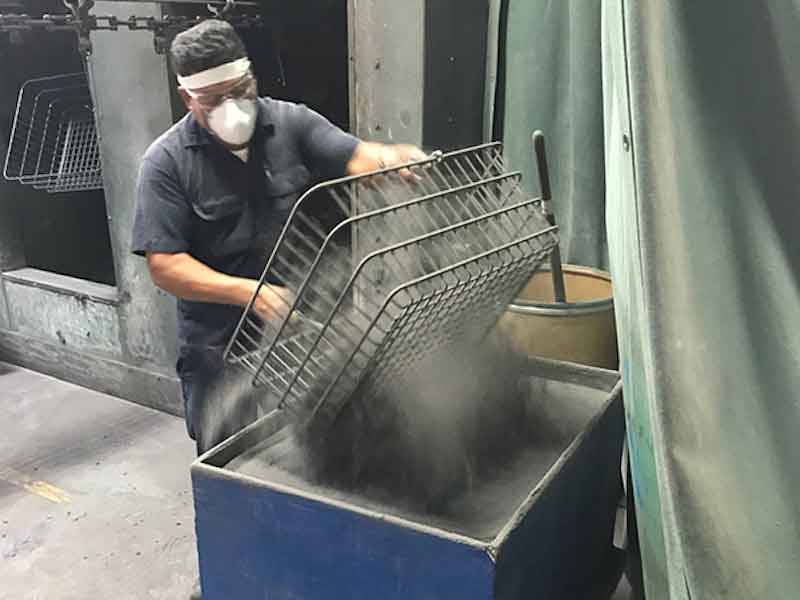“What’s better: spray or dip?” I get asked this question a lot regarding thermoplastic powder coatings.
 Fiona Levin SmithThe two processes could not be more different. Electrostatic spray powder (ESP) is an elegant process that employs a carefully metered amount of powder that is propelled through an electric field that makes the charged particle race towards the grounded part resulting in a nice, wonderfully-even coating.
Fiona Levin SmithThe two processes could not be more different. Electrostatic spray powder (ESP) is an elegant process that employs a carefully metered amount of powder that is propelled through an electric field that makes the charged particle race towards the grounded part resulting in a nice, wonderfully-even coating.
On the other hand, fluidized bed dipping (FBD) is a brute force endeavor, if there ever was one. A hot part is submerged in a bed of fluffy powder, moved around with great agitation to keep the film build even, and once out of the bed; the part is vigorously shaken to remove excess powder—lots of agitation and shaking. However, there is no metering, no pumps, no coating booth, no electrostatics; just a hot part and a bucket of powder with a little air in the bottom. Simple, but perhaps a little less elegant.
Since these two processes use vastly different mechanisms to apply powder, it is not surprising there are many pros and cons with much to be considered. Let’s dive in and compare:
- Shape of the Part – This is the single most important factor when considering ESP vs. FBD. And it is best explained by what does not work for both processes. FBD is actually a flood-coat-and-remove-excess proposition. So if your part has internal surfaces where the powder cannot displace the air (think upside-down glass being pushed into water) that cannot be overcome by the orientation of the part, FBD is not the best choice. The same goes if the excess powder can be trapped and not removed once the part comes out of the bed. ESP comes up short when addressing Faraday cage issues. Welded weld wire parts are great examples. No matter how much the ESP process is optimized, there will always be less coating in the cross welds, which is exactly where you want the most coating for corrosion performance. Since the cross welds are generally a heat sink due to more mass, FBD generally applies more coating in the cross welds than the rest of the part.
- Color changes – The immediate advantage goes to ESP. Depending on the level of automation and color-dedicated equipment, changeovers can be well under 15 minutes. Not bad! FBD has the potential to be even faster, but it requires a dedicated fluid bed tank for each color. Since there are no coating booths, guns, air lines, recycle streams, filters, etc., to clean, and FDB changeover can be as fast as rolling out one tank and rolling in another, and reconnecting the air supply. This is routinely done in under 2 minutes.
- Speed of the coating process – FBD coating has a clear advantage, and the bigger the part, the bigger the advantage. FBD can utilize an incredibly large amount of powder very quickly. A park bench that requires 10lbs of coating will be dip-coated in 8 to 12 seconds. When this is compared to a typical ESP gun that delivers about 1 pound of powder per minute, it is a stark comparison.
- Coating thickness consistency – It’s difficult to decide which one has the edge. A well-tuned ESP process can hold thickness tolerance quite well. But surprisingly, dip coating can be just as good or better. Why? There’s actually not that much that can go astray: 1. consistent preheat temperature; 2. dip time (as long as you actually measure the time, no “One Mississippi” counts); 3. consistent fluidization level. Control these relatively easy parameters, and the coating thickness consistency will be second to none.
- Contamination Issues – Also difficult to decide. ESP has many more sources for contamination: coating booth, filters, recycle stream, etc. However, the most common source of contamination in an FBD process is contamination in the fluid bed itself. And the only correct way to fix it is to dump all of the powder out and refill it with a good powder. This can be a $5000+ event in some larger fluid beds. Keep a tight lid on your fluid bed tank when it’s not in use.
- Metal thickness differences – ESP has a clear advantage when coating parts with significant metal thickness differences. FBD relies on the preheated metal to dose out the heat to melt and build a film. Thinner metal runs out of heat faster than thicker areas, resulting in a thinner coating.
- Part flexibility vs. Same part – If you’re looking for the ability to coat almost any part that comes your way, ESP is the clear winner. FBD coating can be great for doing similar parts every day, but it lacks the flexibility to coat a wide variety of part shapes and sizes. It is very rare for coating job shops, where flexibility is paramount, to have FDB coating capabilities.
- High coating thickness – When coating thickness over 10 mils is desired, FBD is the clear winner. At 20 mils and higher, it is close to being the only choice.
There you have it. Both application methods have their advantages and disadvantages, and to be fair; we’re a fan of both – as long as it’s suited to the part.
Fiona Levin-Smith is Vice president of Marketing and Specification for IFS Coatings. For further questions or inquiries, visit www.ifscoatings.com



































